As you know, Birds are my area of expertise, but I do have a love of the natural world as a whole, with each group of living things catching my eye or ear, or sometimes nose in a particular way.
I purchased a Skinner type moth trap back in 2007, but have only recently rekindled my interest again, largely down to the lockdown situation leading to more time to examine the wildlife on my doorstep more closely.
Some productive nights in my Hollywood (Worcestershire) garden have produced some real gems, making the early starts worth while, maybe every day should start with an Elephant Hawk Moth…

Yes there really are Pink insects. The colour of the Elephant Hawk Moth matches that of its larval food plant, Rosebay Willow-herb.
Moths are split into two main groups, Macro Moths and Micro Moths and as the names suggest, the former are generally larger. The truth is though that the Macro moth group covers particular families of moths, which happen to be larger, whereas the Micro’s are the earlier orders of moth families, so there is some cross over in sizes.
Because of their size, the ‘Macros’ tend to be easier to identify and with close to 900 species in the UK, there is plenty to occupy the moth enthusiast. I use the ‘Field Guide to the Moths of Britain & Ireland’ to help with identification, where life-size illustrations by the king of insect art himself Richard Lewington, make the sometimes daunting task of moth ID so much easier.
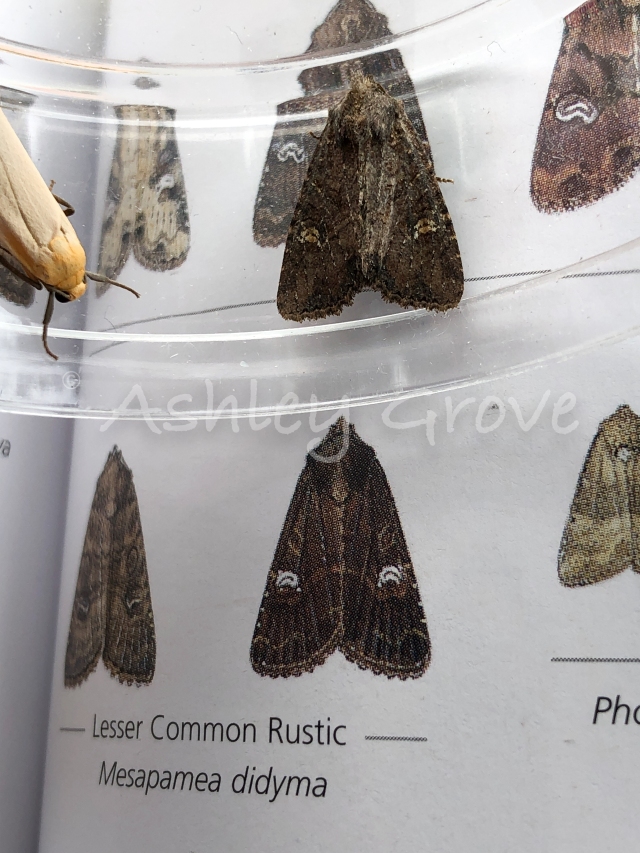
Lesser Common Rustic, one of many similar moths, but being able to offer a live specimen against an accurate scale illustration doesn’t half help.
Obviously what comes to the light will depend on the plants you have in the locality, as each moths caterpillars will be reliant on a particular food plant, with the likes of Hawthorn, Bramble and Oak supporting a wide variety of species for example. If you plant for butterflies and bees in your garden, you are likely supporting moths during the night as well. Honeysuckle and Jasmine are more fragrant from dusk to dawn to attract moths, which are the main pollinator of these plants.
Moth caterpillars are often persecuted by gardeners, but everything has its place and if you have mint in the garden, you may have come across the fabulous purple and gold Mint Moth, or perhaps the pearlescent Box Tree Moth may visit your topiary bushes, both surely worth loosing a few leaves for. After all if a species is to survive it’s not going to fully destroy its larval food plant, otherwise there would be non for future generations. These very same caterpillars might grow into the moths that help pollinate other favourite flowers in your garden, so live and let live is the way forward.
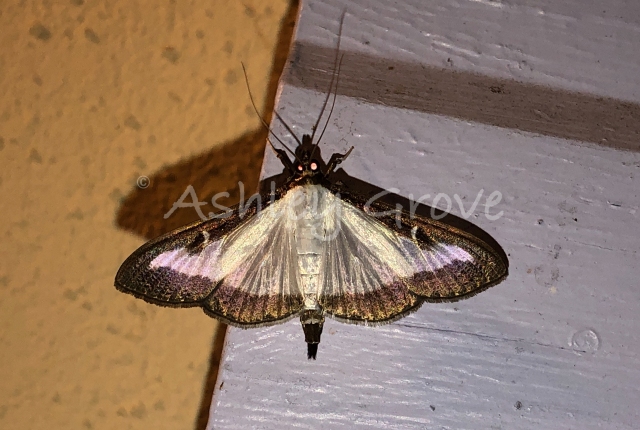
Box Tree Moth, photographed with flash to best show off those pearlescent wings.
The winter months are obviously not good for moths and although a few species do still take to the wing at this time, moth trapping is most producing on a calm, slightly overcast late Spring through to Autumn night. Like butterflies, moths have specific flight seasons, these will coincide with the growth of the particular larval food plants for that species.
Attracting the moths to light to capture them may seem cruel to some, but they settle down into shaded areas within the trap overnight and once identified the following morning, are set free into the same locality and ideally into thick cover so the birds don’t find them. Logging the sightings onto the ‘National Moth Recording Scheme‘ website provides a national picture, much like the British Breeding Bird Surveys do. This of course shows the health of the various populations and movement of certain species, which all adds weight towards conservation and protection of their habitats.
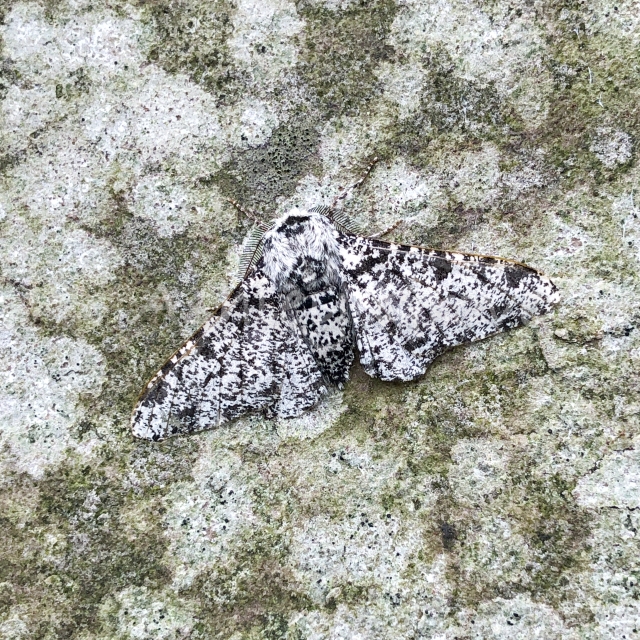
The Peppered Moth larva feed on a variety of plants and trees, giving them a long flight season between May and August.
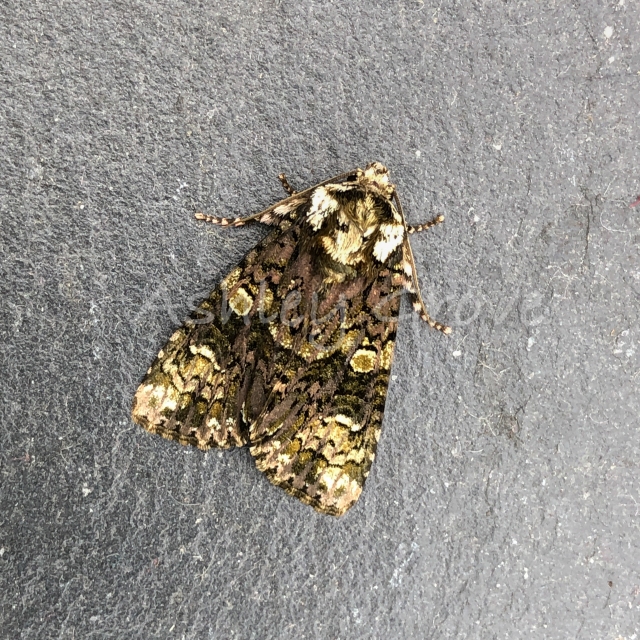
The Coronet has more specific food plants, so will only be found in June & July as an adult moth.
Going mobile with your moth trap will likely find you new moths and you can power the trap by generator to reach more remote locations if you wish. I recently set up at a local house, which has extensive gardens and adjacent wild meadows.

5am at Broadacre House, I wonder whats in the trap?
I think it was Forest Gump who said “Life is like a box of Moths, you never know what you’re gunna get” or something like that anyway, so it’s all very exciting approaching the trap, turning the light off and peering inside.
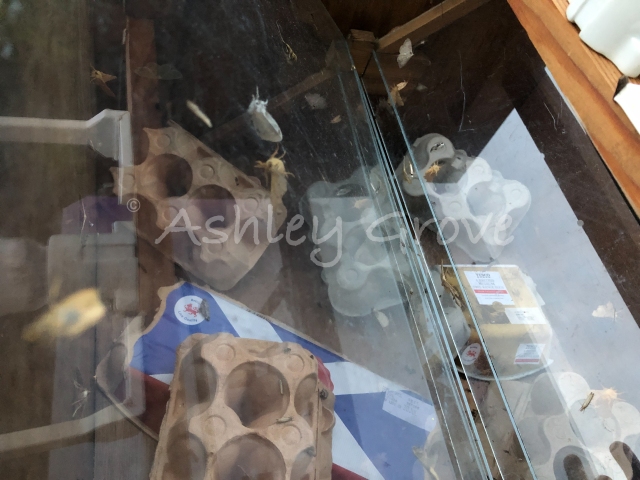
What do we have in here?
There is normally something that immediately catches your eye, a particularly bright or large moth, or an overwhelming number of a particular species. On this occasion there were lots of Footman Moths and Thorns.
Above the very similar Common Footman (left) and Scarce Footman. Both have the same colouration and size of around 14-17mm in length, but they fold their wings differently so making the Scarce Footman appear slimmer.
Not only do you have different species that are similar, you also have huge diversity within the same species, even within the same locality. The four moths together in the picture below are all examples of Dun-bar.
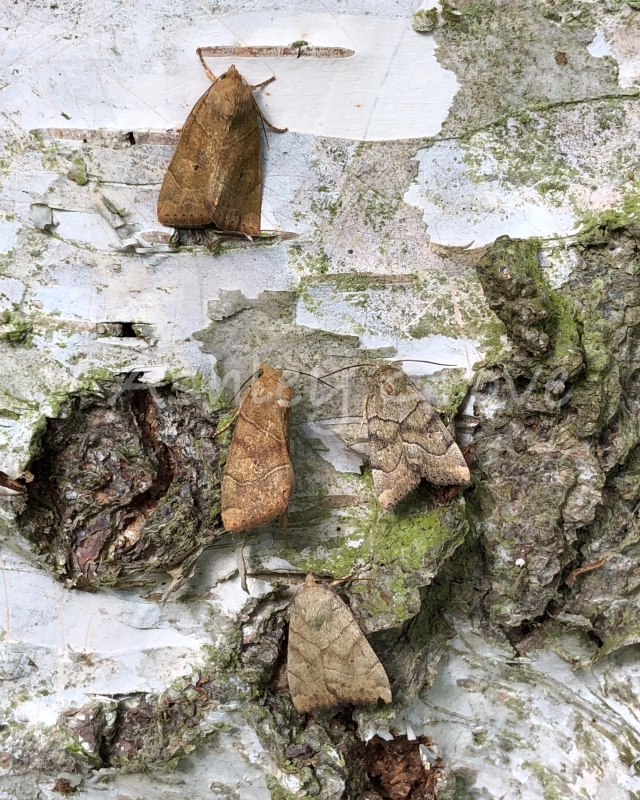
Variations of Dun-bar Moth
However there are some stand out beauties that are unlikely to be mistaken for any of the other moths, like the striking Black Arches below, which even has a pink abdomen and antenna like a gremlins ears.
It was nice to have three species from the ‘Prominent’ family at Broadacre as well, as they are a striking group of moths and a very distinctive shape at rest to help them blend into their background.
Getting your own kit together to do some moth trapping is not cheap, with a Skinner type trap coming in at around £200, but you could have a go at making your own. For an idea of what you might need, Anglain Lepidopterist Supplies is a good a place to look as any.
If you’re not ready to take the plunge, why not attend a moth event. I’ll be running one at Broadacre House, near Solihull on August 28th which will be open to just five people to keep things manageable in these awkward times. This will give people a chance to learn a little about moth identification first hand and an excellent opportunity for some photography of hard to find species. You’ll find details on my websites ‘Events Page‘.
Or if you’d like to find out what moths are visiting your garden without investing in a trap, why not contact me about setting my trap up in your garden overnight and I’ll come back the following morning and we can ID your moths together.
I hope you’ve found the above article interesting and I’ll round it up with an image of one of my favourites, the aptly named Peach Blossom.

Peach Blossom Moth on Silver Birch











Thanks Ashley. Like you, my main area of interest (unlike you, I couldn’t claim “Expertise”) is birds but I too have a love of the natural world as a whole (I trace that back to childhood and to A-level Zoology and Botany – I understand they no longer teach them as separate subjects which suggests a more superficial approach!). I think I’ve spent more on Field Guides during lockdown than on anything else. I’ve been contemplating a book on moths so your recommendation is very timely!
My low cost moth trap is an open window with the light on in my office/spare bedroom while pouring over/editing my day’s photos of birds and any other wildlife. Managed to photograph a Swallow-tailed Moth (Ourapteryx sambucaria) that way. Was also lucky to be at my local reserve (Tice’s Meadow Nature Reserve) when a local moth expert used a pheromone lure to catch a Lunar Hornet Moth (Sesia bembeciformis) – which, of course, looks nothing like a moth except for its antennae – one photo I would not have got without that artificial aid. In return, I’ve added 2 new species of Hoverfly and 1 Bee to the reserve’s Pan-Species List.
Looking forward now to the Scilly Isles trip (thanks for your recent update on that) as my bird list has stagnated recently – I need to visit some different locations!
Regards, Alan
LikeLiked by 1 person
Ha ha, I bet Sue loves “Open window, with light on” moth trap idea Alan. I think the best you can hope for is a stiff neck and a thick ear… Well done on the new species for your local reserve, you’re name will be in the history books forever now. Yes looking forward to catching up with both soon. Take care.
LikeLike
That was fascinating. A good read. Thanks Ashley.
Joan x
LikeLiked by 1 person
Thank you Joan, glad you enjoyed it. Hope to see you soon x
LikeLike